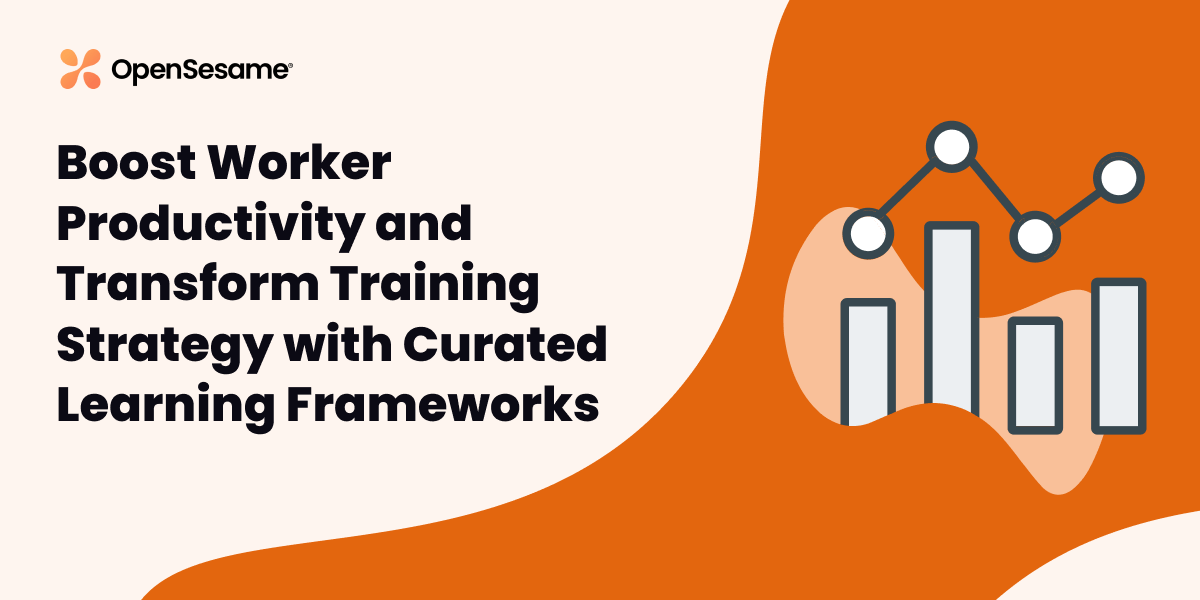Written by OpenSesame employees Ashley Brown, Senior Customer Success Manager, and Paige Kracke, Senior Manager of Curation
Last week at Workday Rising, we presented a session called “Boost Worker Productivity and Transform Training Strategy with Curated Learning Frameworks”. It was so well received we turned it into a blog post!
When it comes to e-learning content, more options are not always better. Whenever possible, learners need to be directed to the best course for them, at the point of need.
Most of us can relate to the experience of opening an entertainment or shopping site (think Netflix, Spotify, Amazon), and immediately finding something that piques your interest, without having to look for it. Those items were often curated for us, are the things we consume, and what keeps us coming back for more. We apply that same concept to your organization’s needs, in a way that customizes the experience for your learners.
Curation is Key
In today’s world, curation is the expectation, and it is no different in L&D. No matter the industry, the challenges and demands of today’s workforce demand that employee training is relevant, timely, and engaging. With over 30,000 courses in the OpenSesame catalog, finding those just right options for your learners can feel daunting (and it is, if you’re doing it alone). Because we know that investing the time to curate meaningful learning is one of the most powerful actions you can take to find long-term success, we offer several tools to make the process accessible (and hopefully, even enjoyable!) for your team.
Curation Alignment: The Framework
Our curation alignment framework is based on four key building blocks:
Foundational: the essential elements of any curation exercise—the nonnegotiables. Foundational attributes ensure that your learning initiative meets basic needs and addresses regulatory requirements.
Preference-based: Content is selected with learner preferences
in mind. Style, format, modality, and length are all taken into consideration, as well as learner demographics.
Contextualized: Individual learning objects are part of a broader competency structure, curriculum, or skills taxonomy. Purpose and desired outcomes are clearly defined, providing a clear context for learning.
Adaptive: Learning programs adapt over time to meet changing needs, preferences, and goals. Learning becomes more tailored over time through regular evaluation and iteration.
Curation Alignment: The Process
Our suggested process includes the four steps below, but this approach is not prescriptive for everyone, and should be modified to meet your needs. No matter the specific steps, the most important considerations are to engage multiple stakeholders and offer opportunities for continuous feedback, so your program improves over time.
- Gather Input
There are many ways to solicit input from learners, both formal and informal. Many organizations offer regular engagement surveys, which can be a rich source of data for L&D. It may also make sense to design a survey specific for learning, or incorporate a feedback component into existing learning sessions, whether in person or online.
- Aggregate Feedback
Regardless of the source of the feedback, if it’s going to be useful, it must be aggregated in some way. Just like the previous phase, this can be formal (e.g., data visualization software), or informal (e.g. Excel or an internal or shared document).
- Curate
This is where the fun begins! Once the feedback has been aggregated, L&D can use the themes that emerge (or share them with OpenSesame) to create competency frameworks, identify courses, and get courses in front of employees.
- Improve
In this phase, the cycle repeats. We know that learner needs change regularly, so while your process must be sustainable, it’s crucial to solicit feedback (and apply it to your program!) on a regular basis.
Lighten the Load: Smartpath by OpenSesame
We know this work is challenging, so we’ve created tools to simplify the curation process, and maximize the return on investment. OpenSesame’s curation team is made up of a group of subject matter experts who will help you build the best curriculum for each part of your business.
Our Curation Alignment Process (CAP) survey is a simple to complete, easy to administer tool that you can share widely to allow multiple stakeholders an opportunity to provide input. The survey includes questions to gather information on the topics that are most important to your team, but also on how people learn best (e.g., courses that are interactive, scenario-based, audio-only, instructor-led, etc.). The survey leverages the power of AI to make recommendations, which are interpreted and refined by our team.
OpenSesame will use your CAP results to custom-create a curriculum for each part of your business, and we will share the results with you so you can continue to make data-informed decisions for employee learning.



Collaboration and Support
In addition to these tools, your OpenSesame Customer Success Manager is here to support you every step of the way, not just with the initial curation, but as a consistent source of support to help you keep your learning options fresh and engaging. Together, we can help you achieve your learning & development goals, optimize your budget and increase your return on investment with training.

